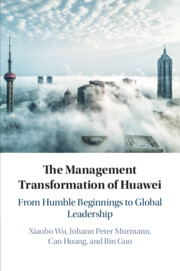Book contents
- The Management Transformation of Huawei
- The Management Transformation of Huawei
- Copyright page
- Contents
- Figures
- Tables
- Contributors
- Preface
- 1 The Management Transformation of Huawei
- 2 The Executive Management Team and Organizational Change
- 3 Transforming Product Development at Huawei
- 4 Huawei’s Transformation of Supply Chain Management
- 5 Financial Management Transformation in Huawei
- 6 The Transformation of Huawei’s HR System
- 7 Huawei’s Internationalization Journey
- 8 Huawei’s R&D Management Transformation
- 9 Huawei’s Intellectual Property Management Transformation
- 10 The Management Transformation of Huawei
- Book part
- Index
- References
7 - Huawei’s Internationalization Journey
Published online by Cambridge University Press: 21 March 2020
- The Management Transformation of Huawei
- The Management Transformation of Huawei
- Copyright page
- Contents
- Figures
- Tables
- Contributors
- Preface
- 1 The Management Transformation of Huawei
- 2 The Executive Management Team and Organizational Change
- 3 Transforming Product Development at Huawei
- 4 Huawei’s Transformation of Supply Chain Management
- 5 Financial Management Transformation in Huawei
- 6 The Transformation of Huawei’s HR System
- 7 Huawei’s Internationalization Journey
- 8 Huawei’s R&D Management Transformation
- 9 Huawei’s Intellectual Property Management Transformation
- 10 The Management Transformation of Huawei
- Book part
- Index
- References
Summary
Internationalization plays an important role in Huawei’s transformation from a fledgling Chinese start-up to a powerful multinational company. Huawei’s internationalization is characterized by repeated failures, difficult struggles and unceasing learning by doing. In this chapter, we divide the whole internationalization process of Huawei into three stages based on the different challenges at each stage. They are (1) overcoming the liability of foreignness, (2) managing complexity to achieve synergy from a global perspective, and (3) changing from a latecomer mindset to that of a global leader. For each stage, we summarize and discuss how Huawei adopts routinization and de-routinization strategies to efficiently overcome different challenges. The managerial implications derived from Huawei’s internationalization will be useful for other multinational firms.
Keywords
- Type
- Chapter
- Information
- The Management Transformation of HuaweiFrom Humble Beginnings to Global Leadership, pp. 244 - 291Publisher: Cambridge University PressPrint publication year: 2020
References
References
Reference
- 2
- Cited by



